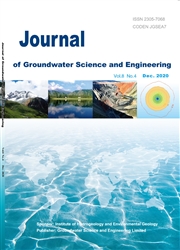Research on changes of hydrodynamics and ion-exchange adsorption in Brackish-Water Interface
作者:MIAO Qing-zhuang,ZHOU Xiao-ni,WANG Gui-ling,ZHANG Wei,LIU Feng,XING Lin-xiao
摘要:In light of multiple field experiments in typical tidal areas with active sea-land interaction, corresponding analysis through hydrodynamic simulation and of ion composition evolution all insist on following conclusions. Due to the tide, the groundwater level is basically in line with its level but with a slight lag. Moreover, smaller amplitude of such changes were always accompanied by greater distance from shores. In this paper, two salt-freshwater interfaces were identified, namely, a large wedge-shaped interface and an inverted U-shaped one located at K5 (monitoring point). The critical hydraulic gradient of saltwater intrusion was between 0.0345 and 0.0377. Apart from that, mathematical and physical models were adopted to measure the influence of tides, showing a inverse proportion to the hydraulic gradient In addition, characteristics of ionic components can prove that K^+ was adsorbed and Ca^2+ was displaced during saline intrusion, while a reverse process was witnessed during desalting. In summary, cation exchange adsorption plus other complex physical chemical effects would take place during saltwater intrusion.
发文机构:The Institute of Hydrogeology and Environmental Geology
关键词:Seawater-freshwaterINTERFACEWEDGE-SHAPEDINTERFACEHydraulicgradientCriticalvalueIon-exchangeADSORPTION
分类号: TV[水利工程]
- Aquifer hydraulic conductivity prediction via coupling model of MCMC-ANN
- Visualizing the spatial water quality of Bentota, Sri Lankain the presence of seawater intrusion
- Characteristics of the main inorganic nitrogen accumulation in surface water and groundwater of wetland succession zones
- Analysis of occurrence characteristics of geothermal resources and its relation to control structures in Zibo City, China
- Delineation of potential groundwater zones based on multicriteria decision making technique
- Foundation pit dewatering optimization design based on GMW-2005 and LGR technique
- Geological characteristics and analysis of hydrothermal genesis in the Suijiang-1 well in Yunnan Province, China
- Characteristics of karst groundwater system in the northern basin of Laiyuan Spring area
- Study on Jinan urban construction planning based on the protection of karst landscape
- Discussion on establishing monitoring networks for temperature fields of shallow thermal energy in Shandong, China


